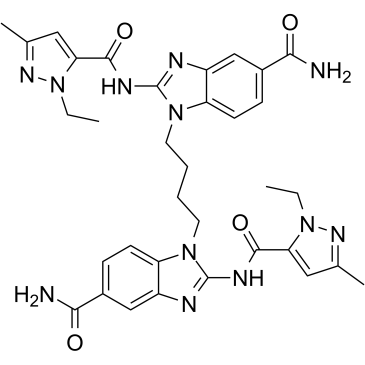STING agonist diABZI compound 2
Modify Date: 2025-08-25 17:32:26

STING agonist diABZI compound 2 structure
|
Common Name | STING agonist diABZI compound 2 | ||
|---|---|---|---|---|
| CAS Number | 2138300-40-8 | Molecular Weight | 678.74 | |
| Density | N/A | Boiling Point | N/A | |
| Molecular Formula | C34H38N12O4 | Melting Point | N/A | |
| MSDS | N/A | Flash Point | N/A | |
Use of STING agonist diABZI compound 2STING agonist-4 is an stimulator of Interferon Genes (STING) receptor agonist with an apparent inhibitory constant (IC50) of 20 nM. STING agonist-4 is a two symmetry-related amidobenzimidazole (ABZI)-based compound to create linked ABZIs (diABZIs) with enhanced binding to STING and cellular function[1]. |
| Name | STING agonist-4 |
|---|
| Description | STING agonist-4 is an stimulator of Interferon Genes (STING) receptor agonist with an apparent inhibitory constant (IC50) of 20 nM. STING agonist-4 is a two symmetry-related amidobenzimidazole (ABZI)-based compound to create linked ABZIs (diABZIs) with enhanced binding to STING and cellular function[1]. |
|---|---|
| Related Catalog | |
| Target |
IC50: 20 nM (STING agonist-4)[1] |
| In Vitro | STING agonist-4 (Compound 2) (0.3-30 μM; 2 hours) causes phosphorylation of IRF3 and STING that is inhibited by the TBK1 inhibitor BX795 and induces dose-dependent secretion of IFN-β with an EC50 of 3.1 μM[1]. STING agonist-4 (Compound 2) (0.001 nM-1 μM) inhibits binding of full-length STING to the solid support with an apparent dissociation constant (Kd) of approximately 1.6 nM[1]. STING agonist-4 (Compound 2) (0-100 μM) is 18-fold more potent than cGAMP (an endogenous STING ligand), with an EC50 of 53.9 μM[1]. STING agonist-4 (Compound 2) (3 μM; 4 hours) promotes production of interferon γ-induced protein 10 (IP-10), IL-6 and TNF-α by a mechanism that is dependent on STING-mediated activation of TBK1[1]. Cell Viability Assay[1] Cell Line: Human peripheral blood mononuclear cells (PBMCs) Concentration: 0.3 μM, 1 μM, 3 μM, 10 μM and 30 μM Incubation Time: 2 hours Result: Caused phosphorylation of IRF3 and STING and induced secretion of IFN-β. |
| References |
| Molecular Formula | C34H38N12O4 |
|---|---|
| Molecular Weight | 678.74 |
| InChIKey | ICZSAXDKFXTSGL-UHFFFAOYSA-N |
| SMILES | CCn1nc(C)cc1C(=O)Nc1nc2cc(C(N)=O)ccc2n1CCCCn1c(NC(=O)c2cc(C)nn2CC)nc2cc(C(N)=O)ccc21 |